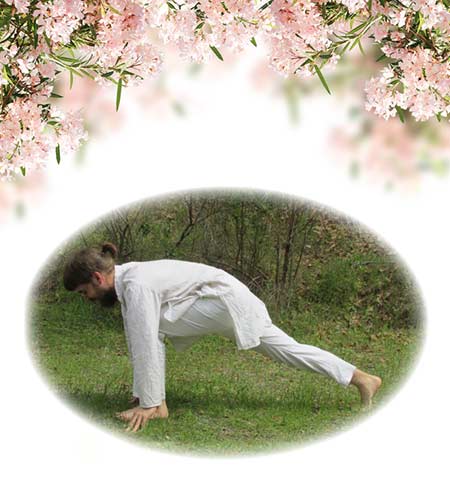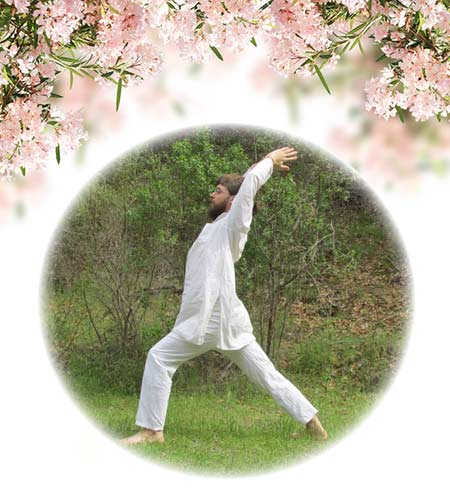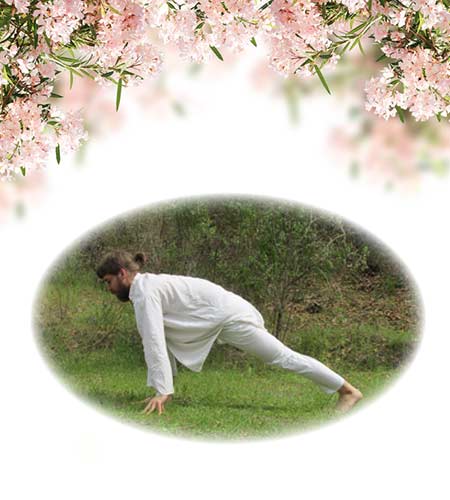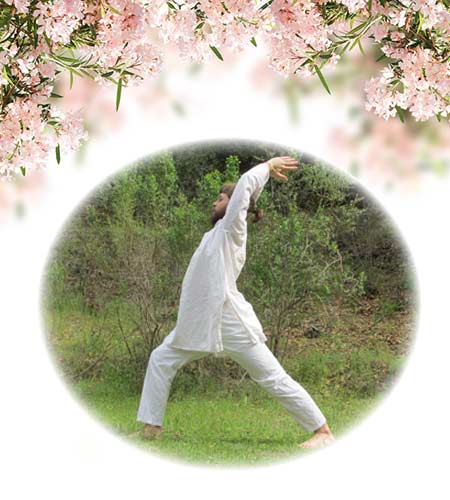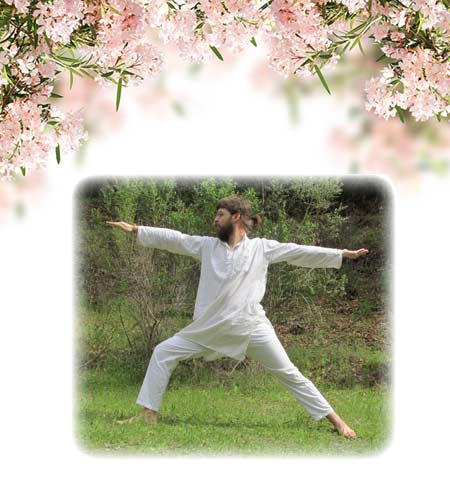Last Updated on January 10, 2025 by

The Shree Maa Asana Sequence is a holistic spiritual practice which creates and maintains a divine vibration and a soothing peacefulness in body, mind, and soul. It is excellent for use as a daily spiritual discipline.
Shree Maa’s yoga practice takes four aspects of Yoga – Asana (physical postures), Mantra (chant), Pranayama (breath control), and Meditation – and weaves them together into one discipline. This weaving together of our spiritual knowledge and practices reflects our understanding of the word Tantra, which literally means “to weave like the warp and woof of a cloth.”
The Benefits of Mantra in Yoga Practice
Mantra – Man Trayate – means “that which takes away the thinking/opinion part of the mind.” By thinking about the mantra, we become free from other thoughts and cultivate its divine vibration within.
In the Shree Maa Asana Sequence, each asana is held for the length of time for you to recite one (or more) mantra(s). For example, you could choose the Mantra Om Namah Shivaya (meaning I bow to the Consciousness of Infinite Goodness) and chant the mantra out loud, or mentally, while holding the pose.
Using Mantra during our yoga asanas has special benefits as best outlined in Chapter Seven of the Devi Gita:

For a beginner, apply one mantra to each asana. As you advance, you can add more recitations of the mantra, or even change the rhythm and control of the breath (Pranayama). You may also do multiple rounds of the standing asana to increase the length of the practice.
A great place to learn the asana sequence is to follow along with this video, as Shree Maa chants the Gayatri Mantra. Alternatively, scroll down the picture gallery of each asana, where you can gain insight into the posture and its benefits. Once you have completed the asana sequence, move forward to the Pranayama Sequence. Here is the video:
Asana Sequence:
Follow this sequence of positions, remembering to hold each asana for the duration of your chosen mantra.
#1 Prakshan/Tadasana – (hands in prayer position standing up straight)


#26 One Leg Seated Fold – (both right leg forward and left leg forward)
Pranayama Sequence:
Once the asana/mantra sequence is complete, apply the pranayama (breathing) sequence. Use your Guru Mantra in order to count or ascertain whether the breathes are equal or are in balance. Inhale the length of one mantra, exhale the length of one mantra.
Bellows Breathing, or Bhastrika Breathing, is a breathing exercise designed to invigorate your body and mind while you forcefully breathe in and out, ensuring that the inhalation and the exhalation are of equal length.
Here are the recommended steps to perform Bhastrika Breathing:
1. Sit in a comfortable posture with back straight. Relax your shoulders as you take a few deep breaths.
2. Exhale forcefully through your nose (belly pushes in)
3. Inhale forcefully through your nose into your diaphragm (belly pushes out)
You may do a round of ten breaths, then resume normal breathing for a few deep breaths. Then repeat two more times.
Here are the steps to perform Anuloma Viloma, alternate nostril breathing:
1. Sit in a comfortable posture with your spine straight

2. Use your left middle finger to right nostril and inhale slowly through your left nostril
3. Hold the breath
4. Use your left thumb to close the left nostril while releasing (opening) the right nostril
5. Exhale slowly through the right nostril
6. Keep the left thumb pressed on the left side of your nose, inhale through the right nostril.
7. Hold the breath
8. Use your left middle finger to block the right nostril and exhale through the left nostril.
This is one round, do for 108 times.
Here are the steps to perform Kapalbhati Breathing:
1. Sit comfortably with spine straight and chin tucked
2. Close your eyes, put hands on knees while touching thumb and index finger
3. Exhale air as forcefully as comfortable through the nose while contracting the stomach muscles
4. Allow the inhale to happen passively, without exertion. Ideally the forceful exhale pushes enough air out of the lungs to cause the inhale to happen automatically
5. Repeat process quickly, ensuring the exhale is done with sharp force
Do for 108 times, counting on the exhale.
Bhramar breathing has a calming effect on entire nervous system and lowers stress. This is a unique pranayama as we create a sound like a honey bee as we breathe. Here are the steps:
1. Sit comfortably with spine straight and chin tucked
2. Close the eyes and relax the whole body for a short time, Relax the jaws and gently close the lips
3. Plug ears with thumbs, eyes with index fingers, nose with middle finger tips, with ring and pinkies above and below the lips
4. Breathe in through the nose, exhale slowly while making a controlled deep, steady Ommmmm sound
5. This is one round. Perform 5 rounds.
Meditation
Directly after Bhramar Pranayam, practice silent meditation for at least 15 minutes. Then, do Bhuta Shuddhi, which is the Purification of the Elements (a meditation using japa of the bija (seed) mantras of each the chakras at least sixteen times).
1:4:2 Pranayama with Japa (recitation of mantra)
End with Pranam (the concluding Mantras for bowing down with devotion)




